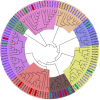Structure, Function, Regulation and Phylogenetic Relationship of ZIP Family Transporters of Plants
- PMID: 32536933
- PMCID: PMC7267038
- DOI: 10.3389/fpls.2020.00662
Structure, Function, Regulation and Phylogenetic Relationship of ZIP Family Transporters of Plants
Abstract
Zinc (Zn) is an essential micronutrient for plants and humans. Nearly 50% of the agriculture soils of world are Zn-deficient. The low availability of Zn reduces the yield and quality of the crops. The zinc-regulated, iron-regulated transporter-like proteins (ZIP) family and iron-regulated transporters (IRTs) are involved in cellular uptake of Zn, its intracellular trafficking and detoxification in plants. In addition to Zn, ZIP family transporters also transport other divalent metal cations (such as Cd2+, Fe2+, and Cu2+). ZIP transporters play a crucial role in biofortification of grains with Zn. Only a very limited information is available on structural features and mechanism of Zn transport of plant ZIP family transporters. In this article, we present a detailed account on structure, function, regulations and phylogenetic relationships of plant ZIP transporters. We give an insight to structure of plant ZIPs through homology modeling and multiple sequence alignment with Bordetella bronchiseptica ZIP (BbZIP) protein whose crystal structure has been solved recently. We also provide details on ZIP transporter genes identified and characterized in rice and other plants till date. Functional characterization of plant ZIP transporters will help for the better crop yield and human health in future.
Keywords: ZIP transporters; functional characterization; genetic modification; homology modeling; transcription factor.
Copyright © 2020 Ajeesh Krishna, Maharajan, Victor Roch, Ignacimuthu and Antony Ceasar.
Figures





References
-
- Ali S., Khan A. R., Mairaj G., Arif M., Fida M., Bibi S. (2008). Assessment of different crop nutrient management practices for yield improvement. Aust. J. Crop Sci. 2 150–157.
LinkOut - more resources
Full Text Sources

